Can Creatures Attack Again After They Are Untapped From Spell
Looking for ways to play? Get started with Magic: The Gathering, and dive into the rules and mechanics, with these great resources!
BASIC TOPICS
- Game Deportment
ADVANCED TOPICS
- Targeting
- The Stack
- Parts of the Turn
Game Deportment
This section describes the actions that you'll take during a game, including tapping your cards, casting spells, and attacking and blocking with creatures in combat.
Borer AND UNTAPPING
To tap a carte is to plough it sideways to show that it has been used for the turn. You do this when you use a state to make mana, when you assail with a creature, or when you lot activate an ability that has the  symbol as part of its cost (
symbol as part of its cost ( ways "tap this permanent"). When a permanent is tapped, you can't tap information technology again until it's been untapped (turned back upright). As your turn begins, untap your tapped cards and then you tin can use them over again.
ways "tap this permanent"). When a permanent is tapped, you can't tap information technology again until it's been untapped (turned back upright). As your turn begins, untap your tapped cards and then you tin can use them over again.
CASTING SPELLS
To bandage a spell, you must pay its mana cost (located in the upper right corner of the card) by tapping lands (or other permanents) to brand the corporeality and Game Deportment type of mana which that spell requires. For example, if y'all were casting Serra Angel, which costs 

 , you could tap 3 basic lands of whatever type to pay
, you could tap 3 basic lands of whatever type to pay  plus two Plains to pay
plus two Plains to pay 
 .
.
Once a spell has been bandage, ane of two things happens. If the spell is an instant or a sorcery, you follow the instructions on the card, and and then you put the bill of fare into your graveyard. If the spell is a creature, artifact, or enchantment, you put the bill of fare on the table in front of you. The carte du jour is at present on the battlefield.
Cards on the battlefield are called permanents to differentiate them from instants and sorceries, which are never on the battlefield.
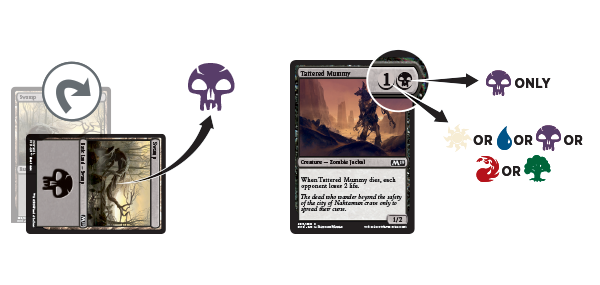
ATTACKING AND BLOCKING
The most common way to win the game is to assault with your creatures. If a beast that is attacking an opponent isn't blocked, it deals damage equal to its ability to that opponent.
The middle phase of each turn is the gainsay phase. In your combat phase, you cull which of your creatures will assail, and yous cull which opponents they volition attack. Tap your creatures to show that they are attacking. Your opponents and then choose which of their creatures will block, if whatever. Tapped creatures tin can't exist declared as blockers.
Once all blockers accept been chosen, each creature—both attackers and blockers—simultaneously deals impairment equal to its power (the number on the left side of the slash in the lower right corner of the card).
- An attacking creature that isn't blocked deals damage to the histrion it'due south attacking.
- An attacking animal that is blocked deals damage to the fauna or creatures that are blocking it, and vice versa.
If harm is dealt to your opponent, they lose that much life.
If one of your attacking creatures is blocked by multiple creatures, you determine how to dissever its combat damage among them. Yous must assign at to the lowest degree enough damage to the first blocking creature to destroy it before you tin assign impairment to the 2nd i, then on.
If a creature is dealt damage equal to or greater than its toughness over the course of a single plough (whether information technology be gainsay damage, harm from spells or abilities, or a combination of both), that creature is destroyed, and it goes to its owner'south graveyard (or "dies"). If a creature takes impairment that isn't plenty to destroy it in a single plow, that creature stays on the battleground, and the harm wears off at the end of the plow.
In the following examples, an opponent is attacking you with a variety of creatures:
In this example, Dwarven Priest is attacking, and you have two creatures that can block. When yous block one attacker with two or more creatures, your opponent must cull the order in which your blockers volition take damage. Remember, the attacking player ever chooses the lodge in which blocking creatures receive damage.
Reclamation Sage and Giant Spider volition bargain a total of 4 damage to Dwarven Priest, which is enough to destroy it. Meanwhile, Dwarven Priest tin deal plenty damage to destroy Reclamation Sage, but not enough to destroy Giant Spider. Since your opponent's Dwarven Priest volition be destroyed in either case, they gild Reclamation Sage before Behemothic Spider so that at least one of your creatures will be destroyed.
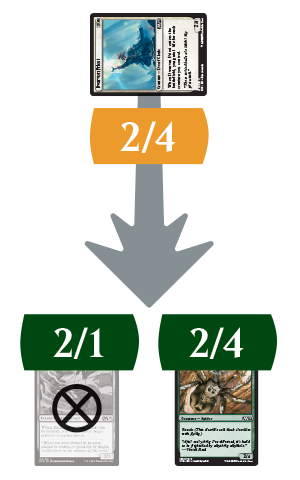
One time blockers take been ordered, damage is dealt. Dwarven Priest deals 1 harm to Reclamation Sage, destroying it, then deals its remaining ane damage to Giant Spider.
Advanced Topics
One of the nigh fun and interesting aspects of the Magic game is the tremendous number of unique cards you tin can play with, which in turn provide an incredibly broad range of things that could happen in any given game. This section is a reference for when you need to know more than details nearly the rules of Magic.
TARGETING
Some spells and abilities employ the word "target" to describe something that the spell or power will affect. You lot must choose all targets for a spell when you cast it, and for an power when it triggers or when yous activate information technology. If you tin can't meet the targeting requirements, yous can't cast the spell or use the ability. For example, if a spell has the text "Destroy target animal," only there are no creatures on the battlefield, you tin't cast that spell because it has no valid targets.
If a spell "deals damage to any target," y'all tin cull any creature or player (or planeswalker, if a thespian has ane) as a target for that spell.
In one case you choose targets, you tin't change your mind later. When the spell or ability resolves, it checks the targets to make sure they're even so legal (that is, they're still at that place and they still match the requirements of the spell or ability). If a target isn't legal, the spell or power tin't affect information technology. If none of the targets are legal, the spell or power does aught at all.
THE STACK
The stack is a game zone shared past all players (like the battlefield) where spells and abilities wait to resolve. Resolving a spell or ability merely means that its effect happens.
Using the Stack
When you bandage a spell or activate an power, it doesn't resolve right away—information technology goes on the stack. Spells and abilities remain on the stack until both players choose not to cast whatever new spells or activate whatever new abilities. Triggered abilities also go on the stack until they resolve.
When y'all have finished putting spells and abilities on the stack, priority then passes to the next actor in plow order, who may desire to use a spell or ability of their own in response. Subsequent players (including y'all) can and so respond to that player's response, so on—the outcome is a "stack" waiting to resolve. Spells and abilities remain on the stack until all players choose non to cast whatsoever new spells or activate whatsoever new abilities.
A general rule is that spells and abilities on the stack resolve one by one, starting time with the final 1 put on the stack.
Responding to Spells and Abilities
When you cast a spell or actuate an power, it doesn't resolve right away—it goes on the stack. Spells and abilities remain on the stack until both players choose not to bandage any new spells or actuate any new abilities. Triggered abilities also proceed the stack until they resolve.
Each player has an opportunity to cast an instant spell (or activate an activated power) in response to any spell or power that goes on the stack. If a player does make up one's mind to answer, their spell or ability goes on the stack on acme of what was already waiting at that place. When all players pass—that is, reject to do anything more—the top spell or power on the stack volition resolve.
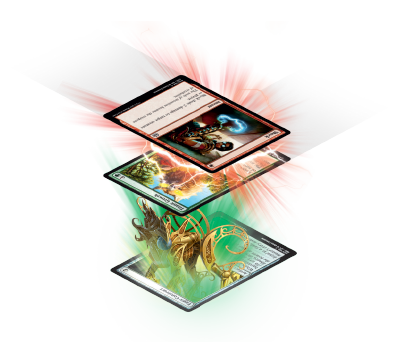
After a spell or power resolves, both players once again become the chance to respond. If no one does, the adjacent affair waiting on the stack will resolve. If the stack is empty, the current pace of the turn will stop, and the game will proceed to the next step.
Example of Spells on the Stack
Your opponent casts Shock targeting your Eager Construct, a 2/2 creature. Shock goes on the stack. You respond to Shock by casting Titanic Growth. Titanic Growth goes on the stack on top of Shock. You and your opponent both turn down to do anything else.
Titanic Growth resolves, making Eager Construct a six/half-dozen until the finish of the plow. Then Daze resolves and deals 2 damage to the pumped-up Eager Construct, which is non plenty to destroy it.
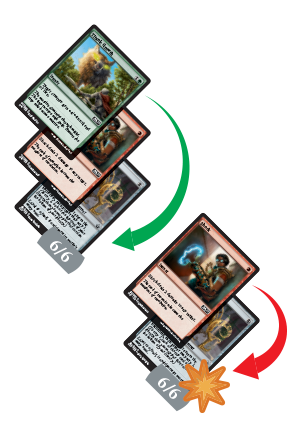
What would happen if Titanic Growth were bandage first?
The Daze would go on the stack on height of Titanic Growth, which ways it would resolve first this time. Shock would nevertheless bargain ii impairment to Eager Construct, but this time that impairment is existence dealt before Titanic Growth can resolve and take outcome—so 2 impairment is enough to destroy Eager Construct!
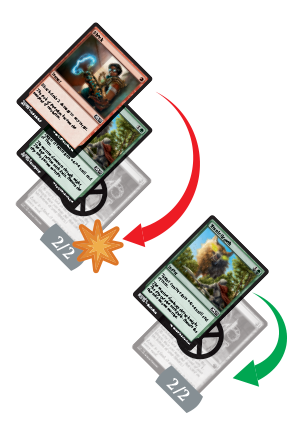
Parts of the Plow
Each turn proceeds in the same sequence. Whenever you lot enter a new step or stage, any triggered abilities that happen during that step or phase trigger and are put on the stack. The active player (the histrion whose turn it is) gets to start casting spells and activating abilities, then each other thespian in turn order volition likewise. When all players refuse to do anything more and nothing is on the stack waiting to resolve, the game will move to the next step.
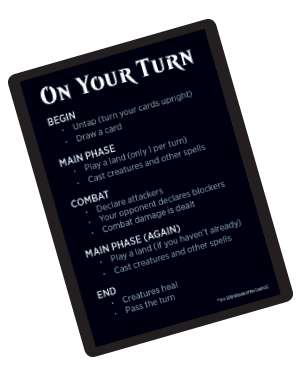
BEGINNING PHASE
- Untap step
You untap all your tapped permanents. On the first turn of the game, yous don't accept any permanents, and then you just skip this step. No one can cast spells or activate abilities during this step. - Upkeep step
Players tin bandage instants and activate abilities. This part of the turn is mentioned on a number of cards. If something is supposed to happen but once per turn, right at the showtime, an power will trigger "at the beginning of your budget." - Draw step
You must draw a carte du jour from your library (even if you don't want to). The histrion who goes outset in a two-thespian game skips the draw step on their first turn to make upward for the advantage of going start. Players can then bandage instants and activate abilities.
Commencement Master PHASE
- Y'all can cast whatsoever number of sorceries, instants, creatures, artifacts, enchantments, and planeswalkers, and you lot can activate abilities. You tin can play a country during this phase, but call up that you tin can play only one country during your plow. Your opponent can cast instants and actuate abilities.
COMBAT Phase
- First of combat step
Players can cast instants and activate abilities. - Declare attackers step
You make up one's mind which, if whatsoever, of your untapped creatures volition assault, and which actor or planeswalker they will set on. This taps the attacking creatures. Players can then cast instants and activate abilities. - Declare blockers step
Your opponent decides which, if any, of their untapped creatures volition block your attacking creatures. If multiple creatures cake a single attacker, you society the blockers to show which will be first to receive impairment, which will be 2nd, and and then on. Players can and so bandage instants and activate abilities. - Combat damage step
Each attacking or blocking creature that's nevertheless on the battlefield assigns its combat harm to the defending player (if it's attacking that role player and wasn't blocked), to a planeswalker (if it's attacking that planeswalker and wasn't blocked), to the creature or creatures blocking it, or to the fauna it'southward blocking. If an attacking creature is blocked by multiple creatures, you lot divide its combat damage among them by assigning at to the lowest degree plenty harm to the first blocking creature to destroy information technology, then by assigning damage to the second ane, and and so on. Once players determine how the creatures they command will deal their gainsay impairment, the damage is all dealt at the same time. Players tin can then cast instants and actuate abilities. - End of combat step
Players tin bandage instants and activate abilities.
2d MAIN Phase
- Your second main phase is just similar your outset chief phase. You tin can cast whatsoever type of spell and activate abilities, simply your opponent can only bandage instants and activate abilities. Y'all tin can play a land during this stage if you didn't play ane during your first principal phase.
ENDING PHASE
- End footstep
Abilities that trigger "at the beginning of your finish step" proceed the stack. Players can cast instants and activate abilities. - Cleanup step
If you take more seven cards in your mitt, choose and discard cards until you have only seven. Next, all damage on creatures is removed and all "until end of turn" effects finish. No one can cast instants or activate abilities unless an ability triggers during this step.
Source: https://magic.wizards.com/en/how-to-play
0 Response to "Can Creatures Attack Again After They Are Untapped From Spell"
ارسال یک نظر